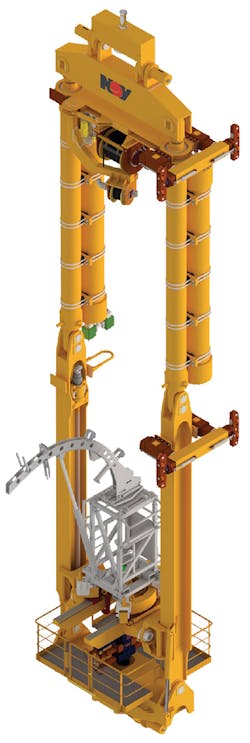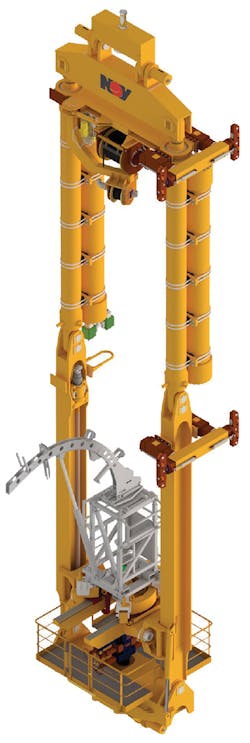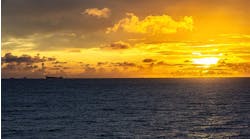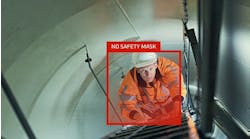Compensated coiled tubing lift frame increases safety, flexibility
Trey Miller
Rachel Bonnette
NOV
Inclement weather and sea state variations create safety risks and increase downtime for offshore projects, including well intervention operations.
Tide cycle changes create challenges for passive compensation system operators, who must make manual adjustments to safely compensate for weight changes. Readjusting for these errors in calculation increases operational time and costs. In addition, maintaining well integrity and operating within designated compensation work windows can create obstacles during operations.
National Oilwell Varco (NOV) Devin technology has encountered these challenges during 13 years of global deepwater completion and post completion intervention projects.
In 2006, onboard a floating vessel in the US Gulf of Mexico (GoM), Devin, part of NOV’s Intervention and Stimulation Equipment business unit, put into operation a motion compensation tower for coiled tubing and wireline services. For this post-hurricane Katrina project, the operator used the Devin Dual Inline Motion Eliminator (DIME) Well Intervention Tower to successfully secure well integrity.
Rendering of the Devin compensated coiled tubing lift frame. (Courtesy NOV)
In 2010, Devin continued post-hurricane season well securement efforts, working with another operator onboard a DP-2 class vessel, performing a 10-month coiled tubing and wireline plug and abandon (P&A) campaign. To mitigate against aggressive weather constraints, Devin installed a cantilevered compensated well intervention tower portside of the ship, saving the operator about $300,000 per day on nine wells.
In 2013, Devin provided a compensation well intervention tower in support of hydraulic workover operations for a three-well intervention program onboard a floating spar platform. Following canister failure identification, the Devin Motion Buster tower became the primary compensator during successful troubleshooting of the buoyancy system, ensuring safety of the crew, operations, and well integrity.
In 2014, when Devin was acquired by NOV, operator demands continued to increase and Devin was called on to assemble a motion compensated coiled tubing lift frame (CCTLF) for operations offshore Nigeria. The CCTLF was rigged up to meet the Express Class rig crane capacity of 86,000 lbs and ensured successful intervention operations while working in up to 14-ft heave conditions. Using the system reduced downtime to 30 minutes, during more than 1,000 operational hours, while compensating over well-center during the four-well campaign.
Next, NOV Devin focused on addressing challenges associated with intervention on floating vessels and in riser-based subsea operations to mitigate risks during offshore projects. Studying the results of global completion and post-completion intervention operations from more than a decade, Devin enhanced existing technology, implementing new motion compensation into the CCTLF. The new technology delivers support for completion and post-completion deployment in coiled tubing and wireline operations. Compared to standard passive compensator systems, the new lift frame helps improve safety, reduce human error, and eliminate the need for manual stroke adjustment.
Air over hydraulic and purely nitrogen passive compensator systems require manual manipulation of energy associated with compensation variance management parameters, such as tidal states. Constant communication must be maintained with coiled tubing operators who bleed and feed nitrogen or hydraulic fluid out of the compensator system as weight is increased or reduced. The new lift frame offers automatic control of tide adjustment with override capabilities, removing human calculation and eliminating frequent readjustment according to lunar cycles.
Installed below the top drive and interfaced with the landing string, the lift frame’s design enables the unit to be rigged up in multiple pieces or picked up as one. The frame may be set up as a backup or primary compensator in parallel or perpendicular position. Even weight distribution across the upper frame assembly, down two legs, and back to the center of the lower frame assembly, which includes a hydraulic elevator door, allows well-center rig up of coiled tubing, wireline, and slickline. Operators may adjust according to rig-specific or application-specific modification requirements. The system features primary and auxiliary hoist lifting units with man rider hoist lifting unit options. Manual activation of onboard and APV valve systems can be actuated via remote control.
By eliminating human error, the CCTLF increases safety during offshore operations. The DROPS-compliant system features remote control hydraulic actuation, enabling hands-free control of upper and lower bail pins; primary and auxiliary hoists; stabilizer arms; injector table; and lower frame assembly articulation with hydraulic elevator door. The system includes indicator-monitoring systems in the drill shack and on the drill floor that provide real-time monitoring of exact tide strokes and fluid levels. When the system detects leaks and low fluid levels, an alarm notifies the operator that the parameters are out of scope, affording more efficient trouble-shooting methods.
Devin will implement this new mode of operation on all newbuild compensators, including the DIME, Motion Buster, Gimble Table, and the Direct Line Compensator.
The design of the lift frame increases operational flexibility, enabling modification of climate- and application-specific requirements. Real-time data monitoring of strokes and fluid levels allows operators to keep parameters within scope and eliminates downtime during inclement weather. The automated features of the CCTLF will enable operators to improve safety, increase the weather working window, and reduce downtime, providing increased cost savings.




